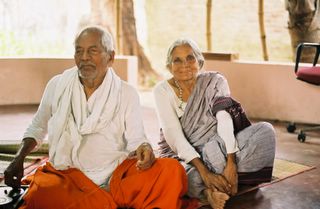The Miracle of Kilvenmani


The awarding of both an Opus Prize and the Right Livelihood Award to Krishnammal this year are truly extraordinary events. But the reality is that these are not the most momentous occasions in the recent life of Land for Tillers Freedom.
In July 2007, three cars pulled up to LAFTI’s headquarters in Kuthur. A group of clearly very wealthy men emerged from each. These men, some very old, and some in the prime of life, and some with their wives and children, were the landlords (and their descendents) responsible for the burning alive of the 4wwomen and children in the village of Kilvenmani on that fateful Christmas Night, 1968, the 44th, an infant, found pinioned to a tree, a knife through its heart. This was the night that launched Krishnammal on her second life’s journey, to rescue the Dalit families of Nagai and Tiruvarur Districts from their milleninum-long servitude.
They came bearing garlands, and fruit, and papers. Lots of papers. They were here to gift their land - all of it - to Krishnammal and the people she serves, an act of restorative justice so surreal as to be almost unfathomable to people who have not followed the course of the struggle for these four decades. The beatings, the imprisonments, the hardships and deprivations, the days, month, years, and decades of “no conflict, no compromise” - Krishnammal’s motto - have now resulted in an act of contrition and atonement that is virtually beyond the imagination.
Some of the land around Kilvenmani had already been wrested from the landlords’ control in the nonviolent struggles that took place in the 1970s, but the symbolism here was unmistakable. An observer noted that the members of the community receiving the land were anxious to shake hands with all parties to the transaction, these same people whose touch only 30 years earlier would have been considered absolutely polluting.
To be sure, the landlords and their descendents are not now about to endure poverty. Most of them have gone off to India’s burgeoning cities, where the majority are sure to prosper. Others have gone to America and elsewhere to seek their fortune. “I don’t wish to deprive them,” says Krishnammal, “they too have marriages and births and occasions of their own to celebrate, and they must be allowed that privilege.”
But the land, and the scene of horrific struggles, and the commitment of a very, very small band of Gandhian organizers identifying themselves completely with the condition of the people, now belongs to the people, and, specifically, the women who till it.
One of the landlords, probably among the key perpetrators, gave Krishnammal the deed to his home. It is almost a palace. Asked whether she would live in it, Krishnammal laughs, “Of course not. Why would I choose to be a slave to a house that size? I sleep every night in a very small space, close to where I will be needed the next day, and how could I possibly care for such a thing?”
As has been the case with other houses gifted to LAFTI, it will now likely be used as a community center, or as a hostel for the children of Dalit migrant laborers.
* * * * *
Today, in the supermarket on Martin Luther King Day, I passed a young woman in the aisle I vaguely seemed to recognize. She definitely recognized me. It was Lauren McCann, the nine-year-old artist who drew the maps for The Color of Freedom. I didn’t recognize her fully because, well, after all, she is now 14.
So, in about three minutes, I explained to Lauren and her mother all the water that passed over the dam since then. The tsunami. The founding of the Friends of LAFTI Foundation. The new redistribution of land. Krishnammal’s tour of the U.S., and the Opus Prize. The Right Livelihood Award. It was like watching a fantastic movie passing before my eyes, and reminds me how intertwined my life has become with these extraordinary people, both in India, and those I have met along this journey. Oh, and I gave her the web address for this blog.
To all of you, thanks for enriching my life, even as we work together to help create and become witness to more miracles.


4 Comments:
hi
i am a journalist and i want to wright a story on amma & appa.
please send me few high resolution photographs of both and your team members.
our team is working on good work of NGO's.
my mail-- eyespy.india@gmail.com
thanks
prabha
This Women's university got established in 1984 by Tamilnadu Government at Anandagiri. Its goals are learning and research with focus on women and their problems. Mother Teresa Women's university earns a distinctive place in the higher educational system as, the only university devoted to women's issues.
The University is of unitary type which offers monitory, consultancy services and research in the area of women's studies.Women University in India The university offers diverse courses whose academic programme is pivoted around women's studies in the discipline of Economics, Education, English, Human Ecology, and Consumer studies, Historical studies,Pshycology, Socioliogy, Tamil and computer science.
Nice blog and good content
Thanks, "Indian doctor". I have so much more to post, but it is hard to keep up.
Prabha - sorry if I missed your deadline - I will write to you.
david
Post a Comment
<< Home